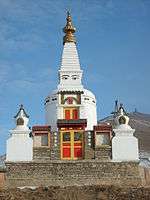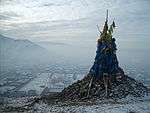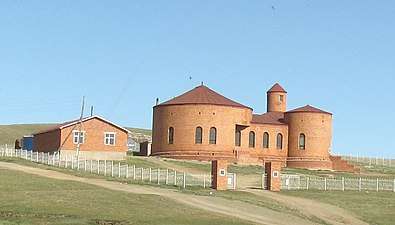Religion in Mongolia
Religion in Mongolia has been traditionally dominated by the schools of Mongolian Buddhism and by Mongolian shamanism, the ethnic religion of the Mongols. Historically, through their Mongol Empire the Mongols were exposed to the influences of Christianity (Nestorianism and Catholicism) and Islam, although these religions never came to dominate. During the socialist period of the Mongolian People's Republic (1924-1992) all religions were suppressed, but with the transition to the parliamentary republic in the 1990s there has been a general revival of faiths.
.jpg)



.jpg)

According to the national census of 2010, 53% of the Mongolians identify as Buddhists, 38.6% as not religious, 3% as Muslims (predominantly of Kazakh ethnicity), 2.9% as followers of the Mongol shamanic tradition, 2.2% as Christians, and 0.4% as followers of other religions.[2][3] Other sources estimate that a significantly higher proportion of the population follows the Mongol ethnic religion (18.6%).[4]
Demographics
| Religion | 2010[5] | |
|---|---|---|
| Number | % | |
| Buddhism | 1,009,357 | 53.0 |
| Islam | 57,702 | 3.0 |
| Mongolian shamanism | 55,174 | 2.9 |
| Christianity | 41,117 | 2.2 |
| Other religion | 420 | 0.4 |
| Not religious | 735,283 | 38.6 |
| Total population | 1,905,566 | 100 |
Main religions
Buddhism
Buddhism in Mongolia began with the Yuan dynasty (1271-1368) emperors' conversion to Tibetan Buddhism. The Mongols returned to shamanic traditions after the collapse of the Mongol Empire, but Buddhism reemerged in the 16th and 17th centuries.After the 1990 overthrow of communism, there has been a resurgence of Buddhism in the country, with about 200 temples now in existence and a monastic sangha of around 300 to 500 Mongolian monks and nuns. According to Vesna Wallace, a professor of religious studies at UC Santa Barbara: "Now more people are coming to temples and visiting monasteries. There is also a new interest in meditation among the general public."
According to the national census of 2010, 53% of the Mongolians identify as Buddhists.
Mongolian shamanism
Mongolian Shamanism, more broadly called the Mongolian folk religion, or occasionally Tengerism, refers to the animistic and shamanic ethnic religion that has been practiced in Mongolia and its surrounding areas (including Buryatia and Inner Mongolia) at least since the age of recorded history. The Mongolian endonym is Boo Morgol (In Mongolian cyrillic: Бөө мөргөл). In the earliest known stages it was intricately tied to all other aspects of social life and to the tribal organization of Mongolian society. Along the way, it has become influenced by and mingled with Buddhism. During the socialist years of the twentieth century it was heavily repressed and has since made a comeback. Yellow shamanism is the term used to designate the particular version of Mongolian shamanism which adopts the expressive style of Buddhism. "Yellow" indicates Buddhism in Mongolia, since most Buddhists there belong to what is called the Gelug or "Yellow sect" of Tibetan Buddhism, whose members wear yellow hats during services. The term also serves to distinguish it from a form of shamanism not influenced by Buddhism (according to its adherents), called black shamanism.Mongolian shamanism is centered on the worship of the tngri (gods) and the highest Tenger (Heaven, God of Heaven, God) or Qormusta Tengri. In the Mongolian folk religion, Genghis Khan is considered one of the embodiments, if not the main embodiment, of the Tenger. The Mausoleum of Genghis Khan in Ordos City, in Inner Mongolia, is an important center of this worship tradition.
Abrahamic religions
Christianity
Christianity in Mongolia is a minority religion. As of 2005, the United States Department of State reports that approximately 24,000 Christians live in Mongolia's capital, Ulaanbaatar, which is around 2.5 percent of the entire registered population of the city. Most Christians in Mongolia became Christian after the end of Mongolia's communist regime in 1990. According to the Christian missionary group Barnabas Fund, the number of Christians grew from just four in 1989 to around 40,000 as of 2008.
Islam
Islam in Mongolia is practiced by approximately 3 to 5% of the population. It is practised by the ethnic Kazakhs of Bayan-Ölgii Province (88.7% of total aimag population) and Khovd Province (11.5% of total aimag population, living primarily in the Khovd city, Khovd sum, and Buyant sum) aimag in western Mongolia. In addition, a number of small Kazakh communities can be found in various cities and towns spread throughout the country.
Bahá'í Faith
The Baha'i Faith in Mongolia dates back only to the 1980s and 1990s, as prior to that point Mongolia's Communist anti-religious stance impeded the spread of the religion to that country. The first Baha'i arrived in Mongolia in 1988, and the religion established a foothold there, later establishing a Local Spiritual Assembly in that nation. In 1994, the Bahá’ís elected their first National Spiritual Assembly. Though the Association of Religion Data Archives estimated only some 50 Bahá'ís in 2005 more than 1,700 Mongolian Bahá'ís turned out for a regional conference in 2009.
See also
References
- 2010 Population and Housing Census of Mongolia. Data recorded in Brian J. Grim et al. Yearbook of International Religious Demography 2014. BRILL, 2014. p. 152
- 2010 Population and Housing Census of Mongolia. Data recorded in Brian J. Grim et al. Yearbook of International Religious Demography 2014. BRILL, 2014. p. 152
- "Mongolia - Population and Housing Census 2010 - Main Findings". National Statistical Office of Mongolia. 2010.
- Association of Religion Data Archives: Mongolia: Religious Adherents, 2010. Data from the World Christian Database.
- 2010 Population and Housing Census of Mongolia. Data recorded in Brian J. Grim et al. Yearbook of International Religious Demography 2014. BRILL, 2014. p. 152
Bibliography
- Heissig, Walther (1980). The Religions of Mongolia, Berkeley: University of California Press
